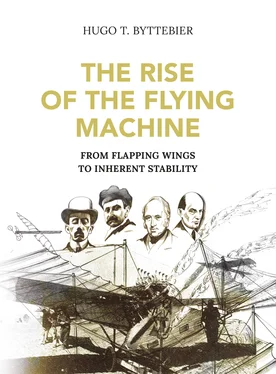Among the members who were enrolled at the 1889 Congress, were two American delegates. The first was Samuel Pierpont Langley. Born in 1834, Langley had just been appointed Assistant Secretary of the Smithsonian Institution in Washington, DC, and the following year he became its secretary.
The Birth of Aviation in the USA
In August 1889 Langley was in the midst of an exhaustive investigation into the aerodynamic properties and behaviour of thin flat planes moving through air at great speed.
The antecedents of Langley’s work go back to an original American enthusiast, named Israel Lancaster who, in his eagerness to discover the secrets of bird flight, had, in 1876 (another flagship year) gone to live in Southwest Florida and remained there for five years in order to watch “the sailing of the master soarers”, as Chanute described them.
In 1886, at a Buffalo meeting of the American Association of the Advancement of Science in Buffalo in New York state, Lancaster presented a paper on the “mechanics of soaring” which caught the attention of S. P. Langley, who was present at the meeting.
Lancaster held some original views, one of which was a theory that a soaring bird, or a man-made model patterned after it, could be made to advance against the wind through a mysterious force which he called “aspiration”. In fact this was nothing more than the thermals or ascending currents described by Pénaud, among others, and the real force that drove the soaring bird forward was gravity.
On hearing this, Langley’s “then dormant attention to the subject” (to use his own words) was aroused by Lancaster’s views and he determined to find out for himself what was or was not possible in the art of heavier-than-air flight.
In 1887, Langley started his experimental research and for that purpose he built an enormous turntable at Allegheny on which, over 3 years, he conducted a great number of experiments described in detail in his essay Experiments in Aerodynamics , published in 1891. In the course of his investigations he hit upon a theory which has been called “Langley’s Law”. This claimed (erroneously) that the faster a flying machine flew, the less power it would need or, in other words: “The force requisite to sustain inclined planes in horizontal motion diminishes instead of increasing when the velocity is augmented.”
One of the important conclusions from Langley’s experiments was again an incontrovertible proof that Newton’s sine-squared law was “widely erroneous” and that thin planes moving through air at small angles could support twenty times as much weight as Newton’s law had calculated. This had already been ascertained by Cayley, de Louvrié and others, but Langley produced scientific experimentally obtained proof of it.
Langley found that a plane loaded at 1 lb/sq ft would be balanced (meaning no vertical downwards pull) at a speed of 42 ft/sec which was 20% more than the 35 ft/sec that Cayley had calculated.
Langley also arrived at a mathematical blueprint for a plane of 10 sq ft surface flying at an angle of 2 degrees at 45 mph, claiming that it would support 209 lbs, with the expenditure of power of 1 hp.
This was of course pure theory because it presupposed a flying machine with wings of 10 sq ft weighing only 1,1 lbs including an engine of 2.5 hp (taking into account transmission losses and propeller efficiency) and Langley himself admitted this in a later (1901) edition of his essay. He had been carried away by his enthusiasm in extrapolating the lifting possibilities of a winged model at high speed instead of calculating from standstill, as he was to learn soon enough when he took up practical experiments.
Another important observation Langley made in 1889 during experiments with a device which he called a “plane dropper”, was that two wings of 15’ x 4’ placed in biplane form four inches apart so as not to interfere with each other, would double the sustaining force of a single such plane; a construction Langley did not himself use in his later experiments but which was not lost upon others. It is clear that in 1889 the biplane concept was born, a concept that, because of its strength and simplicity of construction, dominated aviation until the end of the 1920s.
In his conclusion Langley stated that his experiments did not yet prove that mechanical flight was possible because several practical problems had still to be solved. And to the solution of these practical problems Langley decided to devote the next few years of his life.
The second American member in Paris was Octave Chanute, who had been born there in 1832 but had gone to the US with his parents when he was six years old. After a distinguished career as an engineer specialising in railroads he began to investigate aeronautics in 1884 after he had retired from active business at the age of fifty-two. The last years of his life were then spent in actively promoting the cause of aviation.
Chanute travelled to Paris in 1889 to be present at the aeronautical congress and he read his first aeronautical paper there on 1 August. His French was not perfect, but it was fluent enough to establish an important link between French and American aviation enthusiasts. This was to prove a great boon to the aeronautical movement on both continents.
Chanute’s paper was about the resistance of air on inclined planes and, after sundry mathematical calculations, his conclusion was that fixed-wing gliding flight would require less energy than flapping-wing flight. This was not really a novel theory for the learned listeners, but it was nevertheless well received.
Chanute’s lecture was followed by one by Stephane Drzewiecki, a Russian engineer who covered the same ground as Chanute, although perhaps more thoroughly, and who, after analysing different birds tabulated according to size, weight and wing surface, had arrived at the conclusion that the problems related to human flight had been solved.
This tabulation was the interesting part of Drzewiecki’s paper. The tables were based on findings on sixty-four birds which had been measured, weighed and described with meticulous care by Mouillard in his book of 1881, previously referred to.
Drzewiecki’s tabulation, added to his demonstrations and conclusion, appealed strongly to Chanute, who lost no time in establishing contact with Mouillard as soon as he was back in Chicago. A correspondence with Mouillard ensued that lasted until Mouillard’s death in 1897 and was to have curious as well as far-reaching effects on aviation in America.
Otto Lilienthal
In 1889 a book was published by an eager German enthusiast. The author was Otto Lilienthal, born in 1848, and he heralded the entry of Germany into the field of aviation. Lilienthal, by his experiments with full-size man-carrying gliders up to his fatal final flight in 1896, was an early inductee into the International Air & Space Hall of Fame.
Germany had not at that time contributed much to the advancement of the science of flight, though an exception has to be made for Karl Friedrich Meerwein a century earlier. In 1781 he published an essay with the optimistic title Why should Man not be Born with the Possibility to achieve Flight? A prophetic figure, Meerwein, even before Cayley, had foreseen the possibility that man could emulate birds by means of a machine, as his intelligence and his status as Lord of creation entitled him.
“Why should a man be too heavy for flight?” asked Meerwein. He thought that it would only be necessary to construct a machine with wings large enough to carry his weight aloft. In order to achieve this project Meerwein suggested the use of two flat wings, pointed at the tips and with a high aspect ratio, and which could carry about 2 lbs/sq ft. This turned out not to be far removed from the realities of aerodynamics. The experiment required a courageous volunteer to be attached to the wing in a horizontal position and to flap his arms up and down, which Meerwein perceived as solving the problem. No consideration was given to taking-off or landing, and Meerwein was not very sure about man’s ability to move the wings with his musclepower alone, adding the sound advice that the first attempts should be made over water. He went so far as to build a glider himself, although he achieved no success. In 1784 he published a second pamphlet with the premonitory title: The Art of Flying after the Manner of the Birds .
Читать дальше












